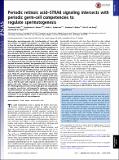| dc.contributor.author | Endo, Tsutomu | |
| dc.contributor.author | Romer, Katherine A. | |
| dc.contributor.author | Anderson, Ericka L. | |
| dc.contributor.author | Baltus, Andrew E. | |
| dc.contributor.author | de Rooij, Dirk G. | |
| dc.contributor.author | Page, David C | |
| dc.date.accessioned | 2015-11-02T18:32:22Z | |
| dc.date.available | 2015-11-02T18:32:22Z | |
| dc.date.issued | 2015-04 | |
| dc.date.submitted | 2015-01 | |
| dc.identifier.issn | 0027-8424 | |
| dc.identifier.issn | 1091-6490 | |
| dc.identifier.uri | http://hdl.handle.net/1721.1/99655 | |
| dc.description.abstract | Mammalian spermatogenesis—the transformation of stem cells into millions of haploid spermatozoa—is elaborately organized in time and space. We explored the underlying regulatory mechanisms by genetically and chemically perturbing spermatogenesis in vivo, focusing on spermatogonial differentiation, which begins a series of amplifying divisions, and meiotic initiation, which ends these divisions. We first found that, in mice lacking the retinoic acid (RA) target gene Stimulated by retinoic acid gene 8 (Stra8), undifferentiated spermatogonia accumulated in unusually high numbers as early as 10 d after birth, whereas differentiating spermatogonia were depleted. We thus conclude that Stra8, previously shown to be required for meiotic initiation, also promotes (but is not strictly required for) spermatogonial differentiation. Second, we found that injection of RA into wild-type adult males induced, independently, precocious spermatogonial differentiation and precocious meiotic initiation; thus, RA acts instructively on germ cells at both transitions. Third, the competencies of germ cells to undergo spermatogonial differentiation or meiotic initiation in response to RA were found to be distinct, periodic, and limited to particular seminiferous stages. Competencies for both transitions begin while RA levels are low, so that the germ cells respond as soon as RA levels rise. Together with other findings, our results demonstrate that periodic RA–STRA8 signaling intersects with periodic germ-cell competencies to regulate two distinct, cell-type-specific responses: spermatogonial differentiation and meiotic initiation. This simple mechanism, with one signal both starting and ending the amplifying divisions, contributes to the prodigious output of spermatozoa and to the elaborate organization of spermatogenesis. | en_US |
| dc.description.sponsorship | Howard Hughes Medical Institute | en_US |
| dc.description.sponsorship | National Institutes of Health (U.S.) (Pre-doctoral Training Grant T32GM007287) | en_US |
| dc.language.iso | en_US | |
| dc.publisher | National Academy of Sciences (U.S.) | en_US |
| dc.relation.isversionof | http://dx.doi.org/10.1073/pnas.1505683112 | en_US |
| dc.rights | Article is made available in accordance with the publisher's policy and may be subject to US copyright law. Please refer to the publisher's site for terms of use. | en_US |
| dc.source | National Academy of Sciences (U.S.) | en_US |
| dc.title | Periodic retinoic acid–STRA8 signaling intersects with periodic germ-cell competencies to regulate spermatogenesis | en_US |
| dc.type | Article | en_US |
| dc.identifier.citation | Endo, Tsutomu, Katherine A. Romer, Ericka L. Anderson, Andrew E. Baltus, Dirk G. de Rooij, and David C. Page. “Periodic Retinoic acid–STRA8 Signaling Intersects with Periodic Germ-Cell Competencies to Regulate Spermatogenesis.” Proc Natl Acad Sci USA 112, no. 18 (April 20, 2015): E2347–E2356. | en_US |
| dc.contributor.department | Massachusetts Institute of Technology. Computational and Systems Biology Program | en_US |
| dc.contributor.department | Massachusetts Institute of Technology. Department of Biology | en_US |
| dc.contributor.department | Whitehead Institute for Biomedical Research | en_US |
| dc.contributor.mitauthor | Romer, Katherine A. | en_US |
| dc.contributor.mitauthor | Anderson, Ericka L. | en_US |
| dc.contributor.mitauthor | Baltus, Andrew E. | en_US |
| dc.contributor.mitauthor | Page, David C. | en_US |
| dc.relation.journal | Proceedings of the National Academy of Sciences | en_US |
| dc.eprint.version | Final published version | en_US |
| dc.type.uri | http://purl.org/eprint/type/JournalArticle | en_US |
| eprint.status | http://purl.org/eprint/status/PeerReviewed | en_US |
| dspace.orderedauthors | Endo, Tsutomu; Romer, Katherine A.; Anderson, Ericka L.; Baltus, Andrew E.; de Rooij, Dirk G.; Page, David C. | en_US |
| dc.identifier.orcid | https://orcid.org/0000-0001-9920-3411 | |
| dc.identifier.orcid | https://orcid.org/0000-0002-5503-182X | |
| mit.license | PUBLISHER_POLICY | en_US |
| mit.metadata.status | Complete | |
